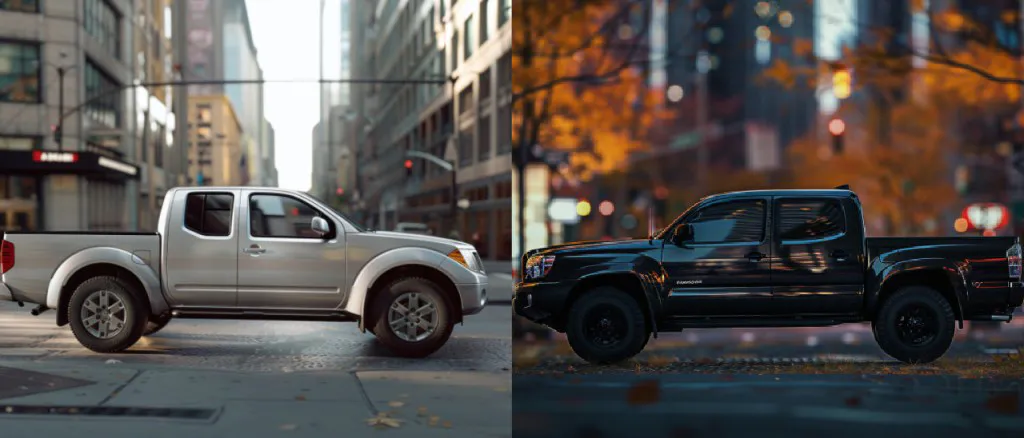There’s no disputing that the Toyota Tacoma is the reigning midsize pickup champion. Strong sales and high resale values evidence this. But winners seeking to stay on top must be aware of what’s coming next. For years, the Nissan Frontier was never a worry. However, the landscape changed with the 2022 launch of an all-new Nissan Frontier. The dowdy and forgettable truck suddenly became a contender.
The 2023 model year represents an interesting crossroads in the midsize truck segment. The Frontier flexes its newly formed muscles while the long-in-tooth third-generation Tacoma enters its final year. But don’t count the Tacoma out. It’s still compelling despite its age. While we all tend to gravitate to what’s new and shiny, the 2023 Tacoma stands out because the 2024 Tacoma will be more expensive and lose V6 power.
Trucks are near and dear to me. I learned to drive in a Ford Courier (a rebadged Mazda pickup from the ’’70s) and a Ford F-150. This was from an era when trucks were either big or small. There was no middle ground (which started in the late 1980s with the Dodge Dakota).
Today, the Nissan Frontier and Toyota Tacoma are just two players in the midsize truck arena (the Ford Ranger, Chevrolet Colorado, and GMC Canyon are the others). But comparing these Japanese brands makes sense.
In researching this matchup between the 2023 Frontier and the 2023 Tacoma, I came away with a few observations. For one, the Frontier represents typical Nissan methodology: offer a few trims at competitive prices. At the same time, Toyota sticks to its usual approach with the Tacoma: sell numerous trims that can slice and dice the market (and sometimes confuse consumers).
While Toyota is well aware that the 2023 Tacoma is past its prime, it refuses to get into a pricing war. Instead, the automaker packs features (like adaptive cruise control and lane departure warning) to add value and remain competitive. The formula works. Last year, Toyota sold almost 235,000 Tacomas in the U.S., making it the automaker’s third most popular vehicle (behind the RAV4 and Camry).
Choosing between the Frontier and Tacoma is challenging. Toyota fans will likely stick with the Tacoma despite its age-related drawbacks (the engine and automatic transmission). However, open-minded shoppers will undoubtedly be tempted by what the Frontier offers.
Continue reading to see how the prices, features, and specifications compare for the 2023 Nissan Frontier and Toyota Tacoma.
Curious about how older Frontier and Tacoma models stack up? Read: Nissan Frontier vs. Toyota Tacoma | The Best Model Year For Every Budget.
Learn more about the methodology used for this article.
2023 Nissan Frontier vs. Toyota Tacoma | A Guide to Trim Levels & Optional Features
Trim Levels: Starting Prices
Quick Take: The Frontier is generally cheaper than the Tacoma, but a thorough comparison of equipment and features is necessary to get a complete picture of starting prices.
Bargain hunters may want to head to a Toyota dealer because the cheapest Tacoma (the SR at $28,600) is less than the equivalent Frontier (the S at $29,190). However, this is an apples-to-oranges comparison because of what’s under the hood. The base Frontier is V6 powered (as are all Frontier trims), while the Tacoma S (and SR) have an inline four-cylinder.
Adding a V6 to the engine bay significantly increases the starting price of the entry-level Tacoma to $30,860. Those who are solely focused on the bottom line may still find the base Tacoma appealing, but the Frontier is a better value.
Comparisons further up the respective trim ranges don’t quite align either. The Frontier SV ($31,890) nestles between the Tacoma SR5 ($30,390) and the TRD Sport ($35,510), but the price gap is due to equipment differences. For instance, the TRD Sport comes with a full suite of driver-assist features (like adaptive cruise control and blind-spot monitoring), which require an upgrade to the Frontier.
Those looking for a more off-road-capable pickup will want to compare the rear-wheel-drive Frontier PRO-X ($35,720) and the four-wheel-drive PRO-4X ($38,720) to the Tacoma TRD Off Road (RWD at $36,790. 4WD at $39,755). Again, the Frontier has a pure price advantage, but the Tacoma gets a few extra bells and whistles.
Going further upscale means leaving the Frontier behind, as the PRO-4X is Nissan’s top offering. However, if you feel like spending more, there are several Frontier upgrade packages. Toyota offers the luxury-oriented Limited ($41,355)—think leather, moonroof, and other premium goodies. Meanwhile, the TRD Pro ($48,035) is the Tacoma flagship with more rugged off-road equipment and the premium touches of the Limited.
| 2023 Nissan Frontier Model | Starting Price |
| S | $29,190 |
| SV | $31,890 |
| PRO-X | $35,720 |
| PRO-4X | $38,720 |
| 2023 Toyota Tacoma Model | Starting Price |
| SR | $28,600 |
| SR5 | $30,390 |
| Trail Special Edition | $41,820 |
| TRD Sport | $35,510 |
| TRD Off-Road | $36,790 |
| Limited | $41,355 |
| TRD Pro | $48,035 |
Cost of Ownership
Quick Take: The Toyota Tacoma is slightly less expensive to maintain than the Nissan Frontier, but not by much.
Wise car shoppers look beyond the window sticker when determining ownership costs. Understanding factors like depreciation and maintenance can often make deciding between two vehicles easier. However, that’s not necessarily the case with this Frontier-Tacoma matchup.
Edmunds estimates that the average owner of a 2023 Frontier will spend $33,870 over five years to keep their truck on the road. The numbers add up to $33,535 for a 2023 Tacoma. A $535 gap ($67 per year) will unlikely sway buyers in a Toyota direction.
Based on 15,000 miles of use annually, that works out to $0.67 per mile for the Frontier and $0.66 for the Tacoma.
Before diving into the data, I was expecting the Tacoma to be substantially less expensive to own due to lower appreciation and reduced maintenance. But other elements came into play. Chiefly, the Tacoma’s substantially higher anticipated fuel costs leveled the playing field.
| 5-Year Ownership Cost | ||
| Costs | Nissan Frontier | Toyota Tacoma |
| Trim | S/Crew Cab/4WD/5-foot Bed | SR/Double Cab/4WD/5-foot Bed |
| Cost to Own | $33,870 | $33,535 |
| Average Cost Per Mile | $0.67 | $0.66 |
| Depreciation | $14,574 | $13,333 |
| Fuel | $12,901 | $14,329 |
| Maintenance | $4,921 | $3,380 |
| Repairs | $724 | $724 |
2023 | Nissan Frontier vs. Toyota Tacoma | Specifications | Safety, Interior, and Exterior Features
Sizing up the Nissan Frontier and Toyota Tacoma involves examining each vehicle’s specifications. Here’s what you need to know.
Vehicle Class & Body Style:
Quick Take: The Frontier and Tacoma are classified as pickup trucks, and both offer two cab configurations.
The sameness between the Frontier and Tacoma continues with vehicle classification. Both are categorized by the U.S. Environmental Protection Agency (EPA) as midsize pickups. What opens doors (figuratively and literally) is that the Frontier and Tacoma each come in two cab configurations.
The Frontier King Cab and Tacoma Access Cab provide two standard doors with smaller rear access doors (a pair of doors with a clamshell-style opening). These are associated with lower trims but certainly meet the needs of some buyers (otherwise, Nissan and Toyota wouldn’t bother).
Alternatively, the Frontier Crew Cab and Tacoma Double Cab offer four standard doors for easier access to the back row and more legroom there, too. See the Exterior Dimensions section (near the end) to review the cargo bed lengths for each truck.
| 2023 Nissan Frontier | 2023 Toyota Tacoma | |
| Class | Midsize Pickup Truck | Midsize Pickup Truck |
| 2-Door Truck | S, SV | SR, SR5, TRD Sport, TRD Off-Road |
| 4-Door Truck | S, SV, PRO-X, PRO-4X | SR, SR5, Trail Special Edition, TRD Sport, TRD Off-Road, Limited, TRD Pro |
olor sit amet, consectetur adipiscing elit. Ut elit tellus, luctus nec ullamcorper mattis, pulvinar dapibus leo.
Powertrain:
Quick Take: The Tacoma’s aging engines are a step behind the Frontier’s more advanced V6. However, the Tacoma gets bonus points for still offering a manual transmission.
Engine Options & Specifications:
Nissan enjoys a good reputation for its VQ series of V6 engines—a design that’s been around for 30 years—which has a home under the Frontier’s hood. With 310 horsepower and 281 lb-ft of torque, the Frontier’s engine has greater output than the Tacoma’s V6 (278 horsepower and 265 lb-ft of torque).
Yet, the Frontier’s greater grunt doesn’t translate into significantly more towing capability. This Nissan has a towing range of 6,270-6,720 pounds against 6,400-6,800 pounds for the Tacoma, essentially a draw.
The one engine outlier is the Tacomas’s wimpy 159-horsepower 2.7-liter four-cylinder engine. To call this near-ancient powerplant (with 180 lb-ft of torque) underwhelming is to be polite. This four-banger also cuts the Tacoma’s towing maximum to 3,500 pounds. In addition, its 0-60 mph time of 9.7 seconds is glacial. To put this performance in perspective, a four-cylinder Tacoma is about as quick as America’s cheapest new car, a Nissan Versa, which costs about $16,000.
So, why does Toyota even bother with this engine? Because of the price. Not everyone needs V6 pulling power or cares about acceleration. Those who don’t need to overly tax a pickup and are content just chugging along will find that a four-cylinder Tacoma meets their requirements just fine.
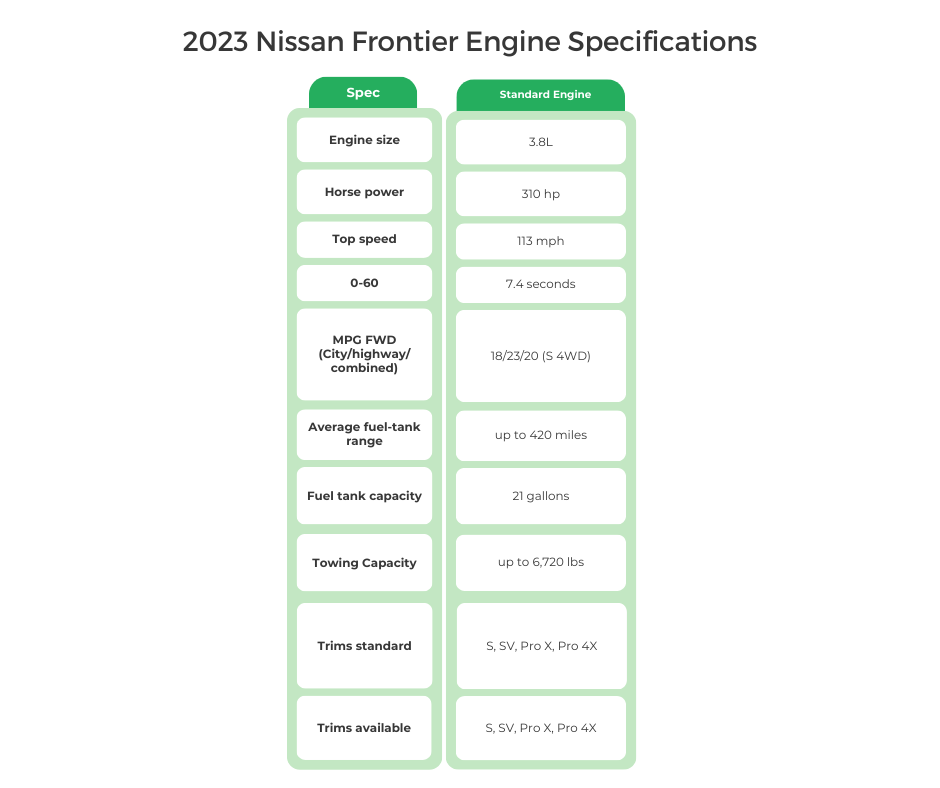
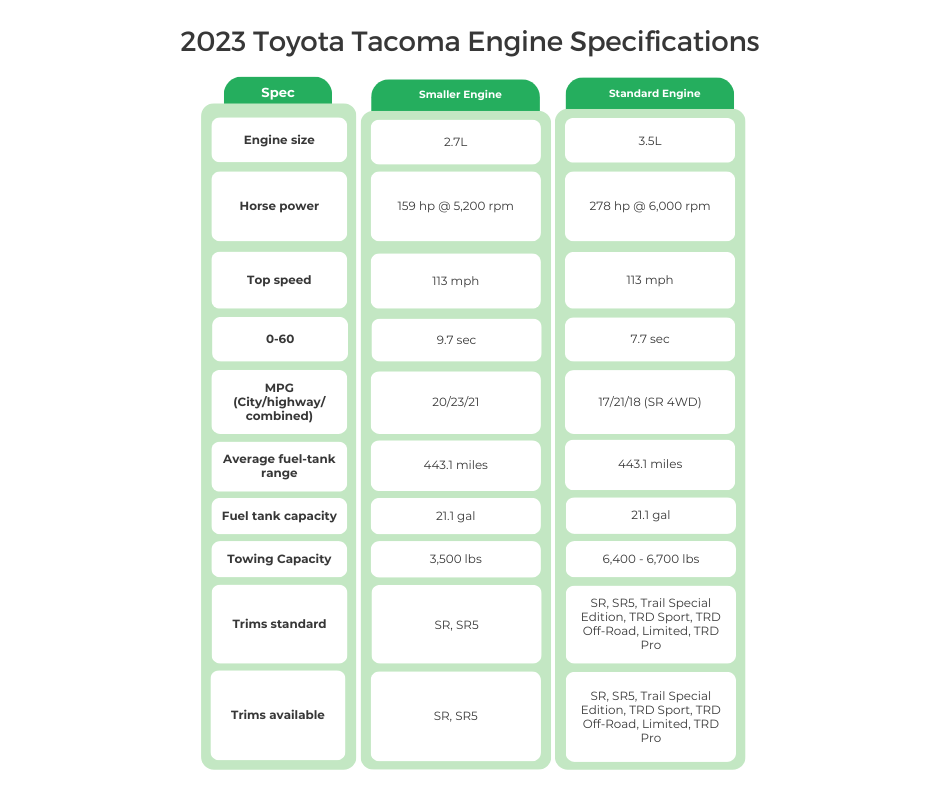
Fuel Economy:
Surprisingly, the Frontier’s greater power has no fuel economy penalty. The Tacoma’s modestly worse mpg also underscores that this Toyota V6 engine is past its prime. Going with a four-cylinder Tacoma saves gas (2-3 mpg), but you’d need to drive a lot to see substantial savings at the pump.
Wondering about fuel economy for an older Frontier or Tacoma? Check out: Nissan Frontier vs. Toyota Tacoma | The Best Model Year For Every Budget.
Transmission Options & Specifications:
Despite Nissan’s love of continuously variable transmissions (CVTs) and the Frontier’s recent redesign, the Frontier’s gearbox is more conventional (an automatic). This is a good thing, as CVTs just can’t handle the rigors of truck use. See the “Tech Talk” section below the charts to learn about CVTs.
What’s not so traditional about the Frontier is its nine-speed automatic transmission, another good thing. More gears help maximize fuel economy and performance (the recently redesigned Toyota Tundra pickup has a ten-speed automatic). Nissan decided to give up on a manual gearbox for the Frontier, undoubtedly to the disappointment of automotive purists.
Yet traditionalists can take comfort in knowing that Tacoma still has an option for row-your-own gears, albeit for a handful of trims. Meanwhile, the Tacoma again shows its age with its other transmission, a six-speed automatic. It’s a contributor to the truck’s lackluster fuel economy.
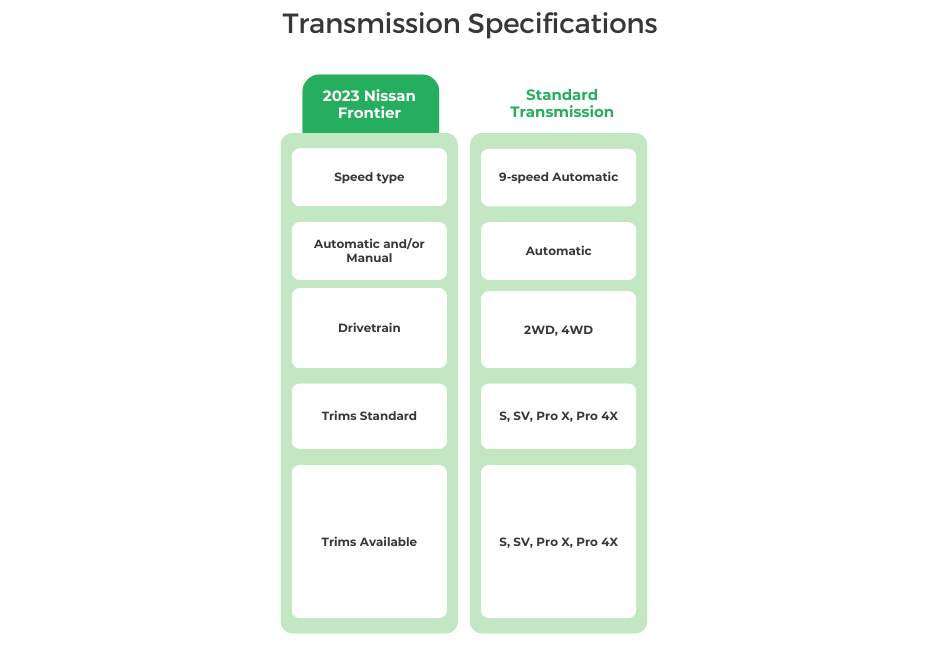
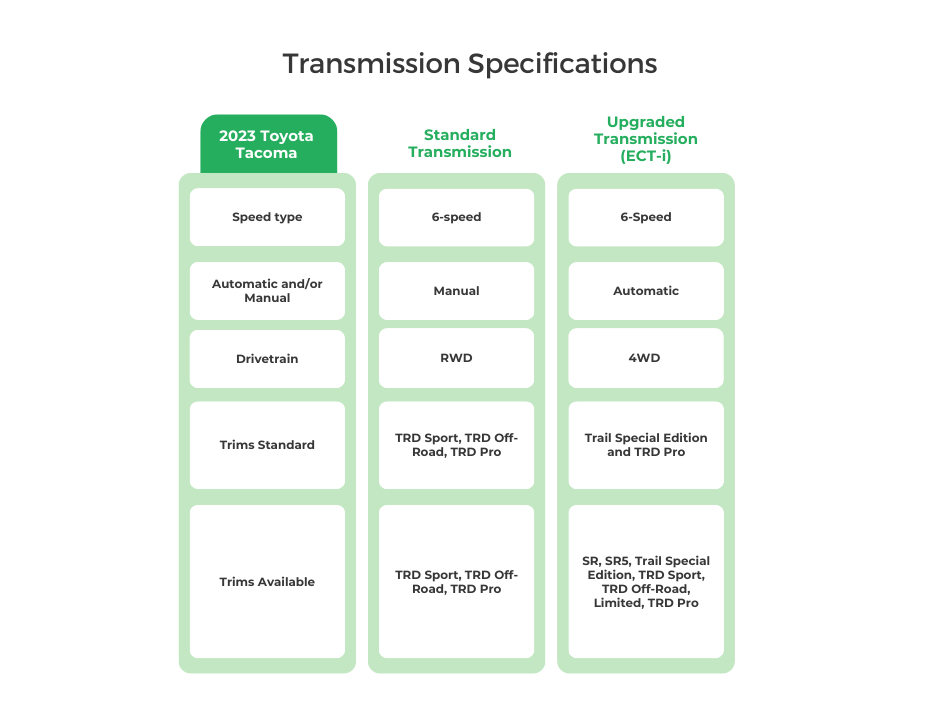
TECH TALK: CVTs
A continuously variable transmission (CVT) does not use gears like a typical automatic transmission. Instead, it has two pulleys connected by a belt. One pulley connects to the engine, and the other connects to the wheels. The belt transfers the power between the pulleys. This setup allows the pulleys to continuously change positions as needed. The CVT automatically adjusts the pulleys as required, providing smooth and efficient power delivery.
Drivetrain:
Nissan and Toyota know that not every truck buyer wants four-wheel drive (4WD). 4WD costs more upfront and adds to extra costs later with worse fuel economy and greater maintenance requirements.
Rear-wheel drive (RWD) aficionados can certainly find options with the Frontier and Tacoma. In fact, all Frontier trims, except the off-road-warrior PRO-4X, came standard with RWD. The same goes for the Tacoma; only the Trail Special Edition and TRD Pro are 4WD-only.
That said, if spinning all four corners is a must, then just about every version of the Frontier and Tacoma has 4WD as optional or standard. Only the Frontier PRO-X is strictly RWD; it’s for someone who wants their truck to look rugged but doesn’t need off-road prowess.
| 2023 Nissan Frontier Wheel Drive | FWD | 4X4 | RWD |
| S | U | S | |
| SV | U | S | |
| Pro X | S | ||
| Pro 4X | S |
U = Available in upgrade
| 2023 Toyota Tacoma Wheel Drive | FWD | 4WD (part-time on-demand 4WD) | RWD |
| SR | U | S | |
| SR5 | U | S | |
| Trail Special Edition | S | ||
| TRD Sport | U | S | |
| TRD Off-Road | U | S | |
| Limited | U | S | |
| TRD Pro | S |
U = Available in upgrade
Safety:
Quick Take: The Frontier and Tacoma have similar overall safety ratings from NHTSA, but the newer Frontier falls short with rollover resistance.
NHTSA Safety Ratings
A comparison of National Highway Traffic Safety Administration (NHTSA) crash test data represents another near tie for these two midsize trucks. Both vehicles have an overall four-star (out of five) rating and matching frontal and side-impact testing results. But there’s more to this story.
This Tacoma generation dates back to 2016, while the latest Frontier edition hit the streets in 2022. Given the Frontier’s newness, I would expect the Nissan to outperform the Toyota. Yet, this isn’t the case. It’s as if Nissan said, “We’ll just match the Tacoma’s NHTSA scores and call it a day.”
I was also floored to see that Frontier has a low three-star rollover prevention score, an underwhelming achievement compared to the aged Tacoma’s four-star performance in this area.
If you’re looking for a reason (or excuse) to lean toward a Nissan purchase, safety is not one of them.
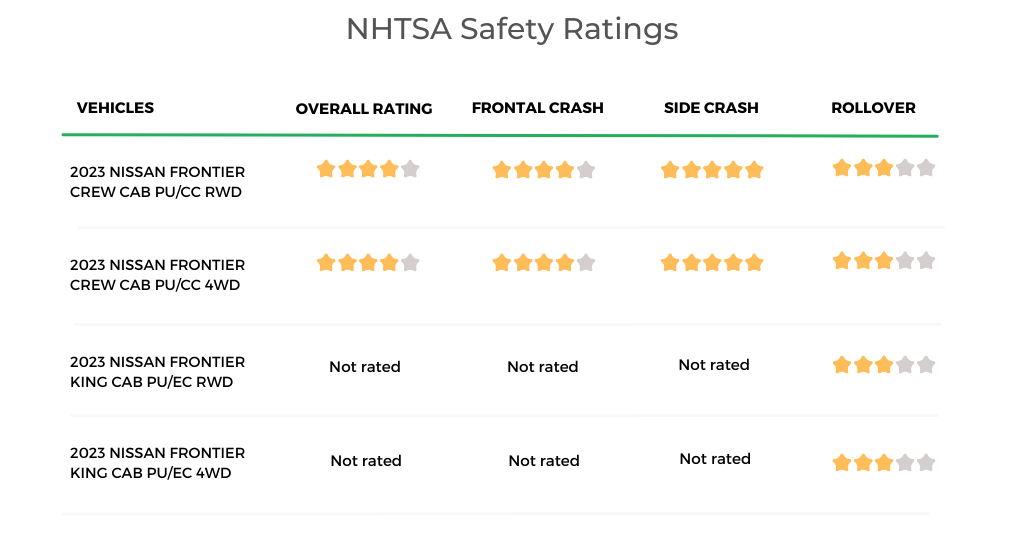
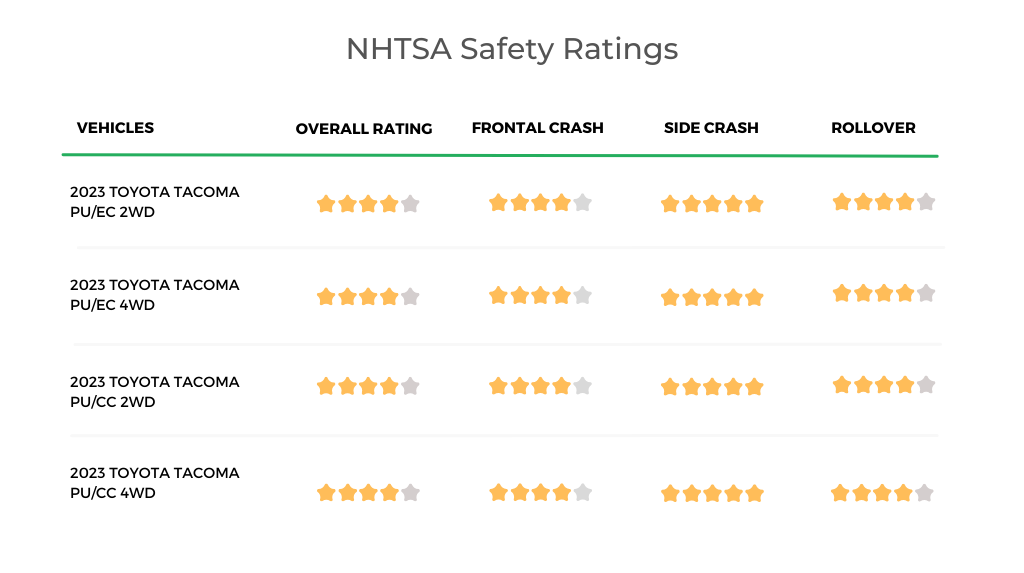
IIHS Awards:
The Insurance Institute for Highway Safety (IIHS) takes a somewhat different approach to safety testing. In particular, it focuses on its small frontal overlap crash test, which the organization feels represents a more real-world scenario (a single car running into a fixed object). IIHS also looks at side impact crashes, roof strength, headlight effectiveness, and advanced driver safety technologies (like automatic emergency braking).
While tested vehicles receive a Good, Acceptable, Marginal, or Poor grade, the true measure comes if a car gets a Top Safety Pick or Top Safety Pick+ designation. If “Good” is a “B” grade, Top Safety Pick notches things up to an “A-,” and the Top Safety Pick+ signifies an “A+.”
Neither truck received an IIHS safety award, putting the Frontier and Tacoma on equal footing in this area.
| IIHS Award | Tested Vehicle | ||
| 2023 Nissan Frontier | Small Pickup/ Crew Cab Pickup | No Award | 2022 Nissan Frontier S Crew Cab 4WD |
| Small Pickup/ Extended Cab Pickup | No Award | 2022 Nissan Frontier SV King Cab 2WD | |
| 2023 Toyota Tacoma | Small Pickup/ Crew Cab Pickup | No Award | 2016 – 2022 Toyota Tacoma SR5 Double Cab |
| Small Pickup/ Extended Cab Pickup | No Award | 2017-2022 Toyota Tacoma SR5 Access Cab 2WD | |
Airbags & Head Restraints:
The Frontier and Tacoma are equally matched with the same airbag equipment. Both have front-row airbags and side curtain units to protect the front and back rows in a rollover or accident. There are also front-row knee airbags that help properly position the body to limit injuries in a front-end collision.
Despite the Tacoma’s advanced age, the truck includes active head restraints among its list of standard equipment. This safety feature, absent from the Frontier, reduces whiplash injuries.
Neither the Frontier nor the Tacoma comes with overhead airbags. This newer technology replaces traditional front-row units (steering wheel and dashboard) with overhead devices. Active head restraints are usually found in specialty and high-end vehicles to minimize whiplash injuries. Mainstream vehicles like the Frontier and Tacoma aren’t usually equipped with this feature.
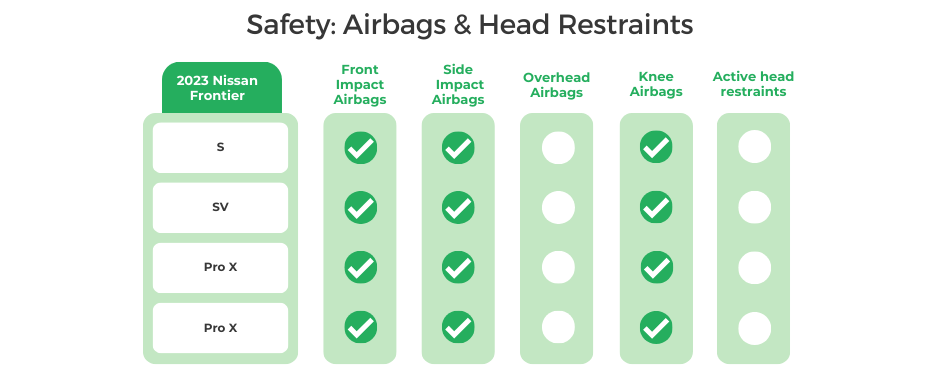

Driver-Focused Features and Equipment:
Quick Take: The Tacoma gets more standard driver-assist features.
Semi-Autonomous Driving:
Hands-free driving systems are making their way into more and more vehicles, including pickups like top-end Ford F-150s and Chevrolet Silverado 1500s. However, this technology isn’t offered in the Frontier and Tacoma. But other included or available features make driving easier and safer.
Both trucks get automatic emergency braking (AEB) with pedestrian detection (or Pre-Collision System in Toyota-speak). Frontier buyers can also opt for rear automatic braking, which prevents low-speed collisions while reversing.
All Tacomas come standard with Dynamic Radar Cruise Control, Toyota’s term for adaptive cruise control (ACC). ACC manages vehicle speed and distance from the car in front, making highway traffic jams more tolerable. Nissan charges extra for ACC, even on the top-dog PRO-4X. Score one for Toyota.
The Tacoma also gets Smart Stop Technology, a feature that prevents unintended acceleration (press on the gas pedal instead of the brake). This is absent from the Frontier.


Driver Warning Systems & Telematics:
The Tacoma’s higher prices make sense when looking at advanced driver assistance systems (ADAS). The Tacoma and Frontier get forward collision warning (FCW) as standard, but the Toyota goes one step further. All Tacoma trims include lane departure warning and telematics (connected services for remote features and help during emergencies). You’ll have to pay extra or buy a top trim to get this equipment with a Frontier.
Blind-spot monitoring (BSM) and rear cross-traffic alert (RCTA) require an upgrade on all Frontier editions, while Toyota includes this tech on higher-end Tacomas (an option on all lower trims except the base SR).
Nissan does include a driver attention monitor on all Frontiers, a feature lacking on the Tacoma.
If ADAS technology appears like alphabet soup, check out an effort from AAA, Consumer Reports, J.D. Power, and other groups working to standardize the terminology for these systems.

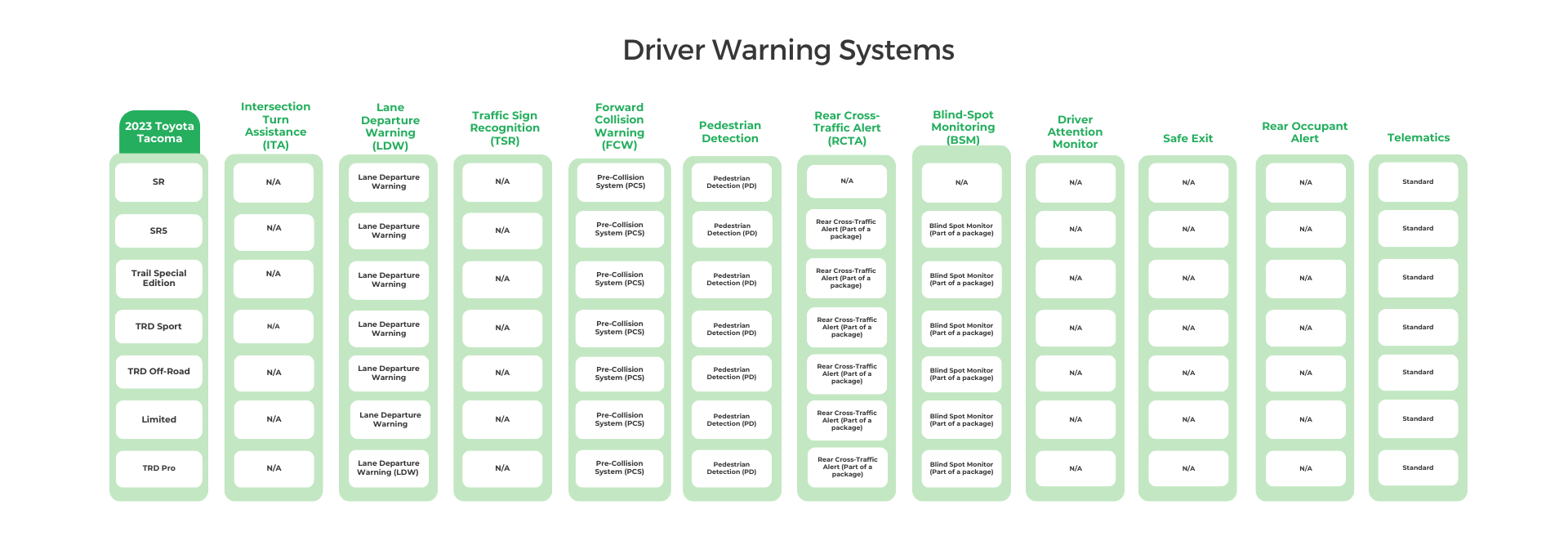
Road Visibility Features:
Sometimes, it’s hard to remember that trucks don’t always have more commonplace features than passenger cars. LED headlights are standard on even the cheapest new Toyota Corolla, but you’ll have to buy a premium Frontier or Tacoma trim (or pay for an upgrade) for improved nighttime vision. At least Toyota includes automatic high beams with the Tacoma (an extra-cost feature with the Frontier). Backup cameras are a federal requirement.
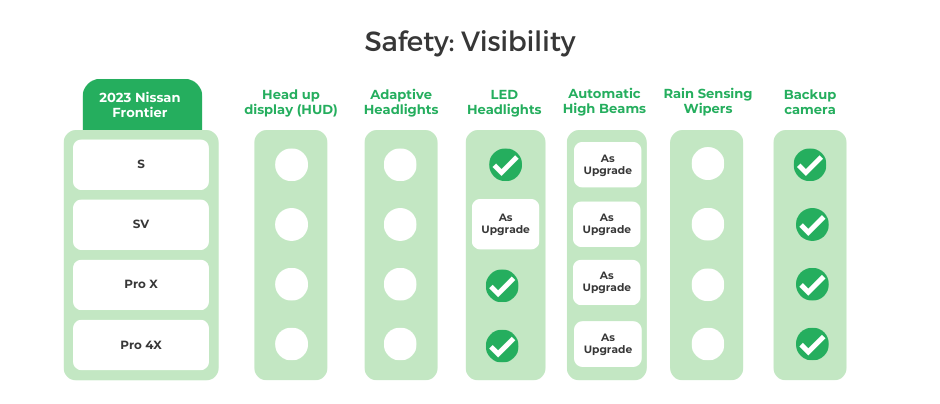
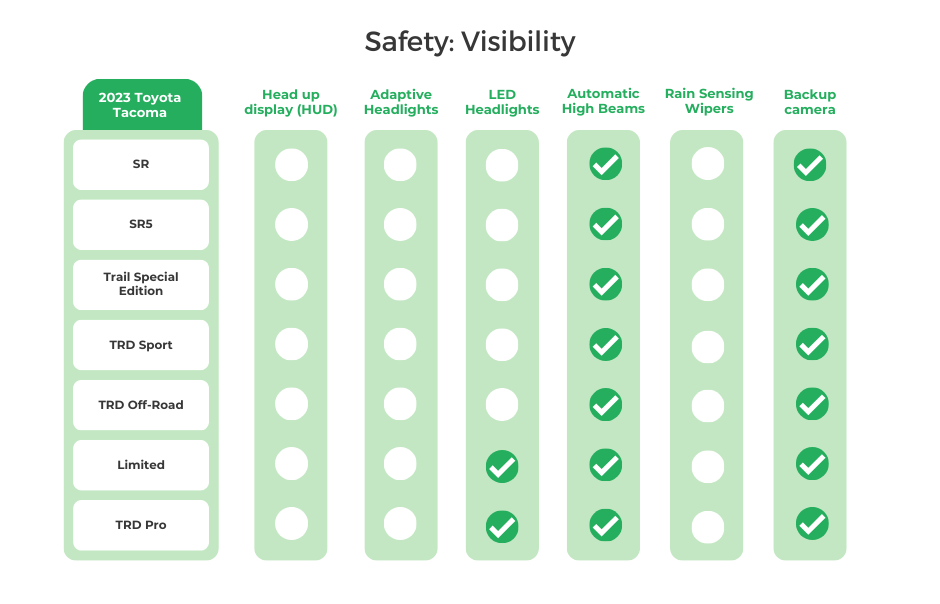
Interior:
Quick Take: Neither the Frontier nor the Tacoma has a significant advantage in interior features or cabin space.
Interior Features:
Nissan and Toyota recognize that many car buyers consider mobile phones as fifth appendages. So, it is mandatory to make Apple CarPlay and Android Auto standard across both model ranges.
However, this philosophy doesn’t apply to heated seats, which are treated as a nice-to-have feature. All Frontiers (except the base S) can be upgraded with these back and bottom warmers. Yet, availability is more restricted with the Tacoma. Heated front seats are an option only on the mid-tier TRD Sport and TRD Off-Road trims and are included with the TRD Pro. However, the real head-scratcher is that luxury-focused Tacoma Limited can’t be had with heated front seats. How would you like to drop $40,000 or more on a high-end truck and find Toyota left this feature off the equipment list? I was so surprised by this omission that I had to quadruple-check the 2023 Tacoma’s specifications.
And speaking of heated seats, some automakers offer this feature through a subscription service. This hasn’t yet happened in the U.S., but in certain countries, BMW offered heated seats for a monthly fee. The advantage is you can shut off the service during warm months, but you’ll need to keep paying (or pay a one-time upfront fee) to activate the heated seats. Recently, BMW announced it was backing away from this practice. Moving forward, the automaker will only charge a subscription for software-based services (like upgraded navigation). Hardware-based features will be part of the vehicle’s initial purchase price.
One industry study shows mixed results for consumer acceptance of features on demand (FoD), with about one-fifth not even being aware of the concept.
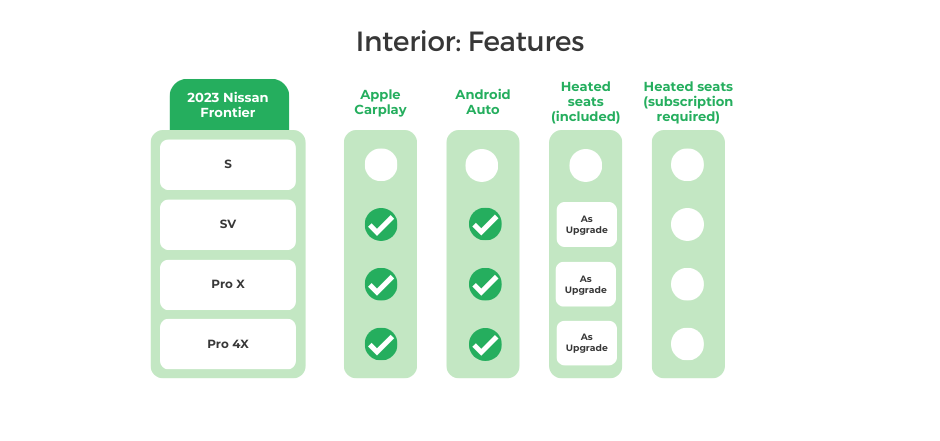
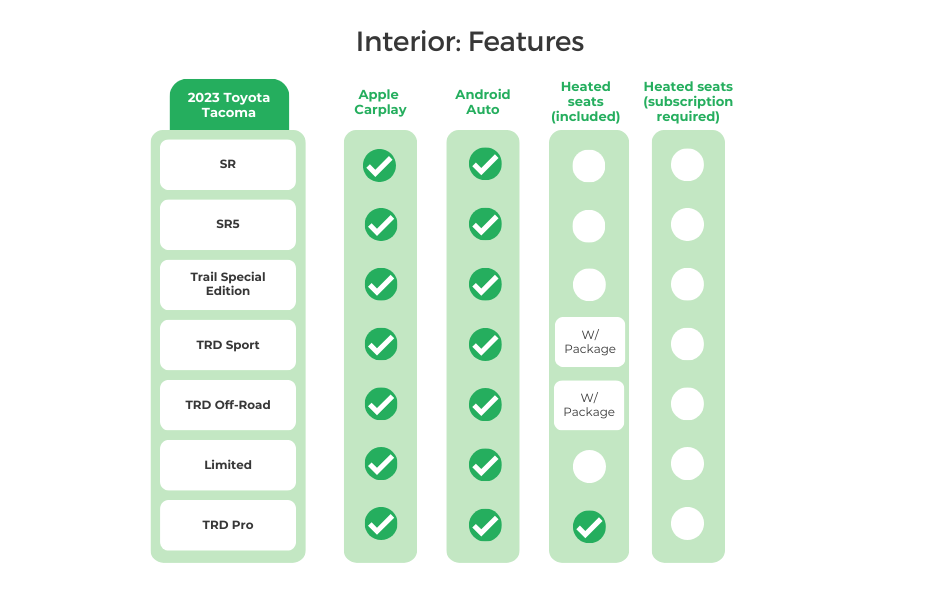
Interior Dimensions:
Interior measurements of the Frontier and Tacoma are fairly matched. There’s less of an inch difference for front legroom, headroom, and front shoulder room. The Frontier has a more noticeable advantage with King Cab second-row legroom. Just know that sitting in the second row of a Frontier King Cab or Tacoma Access Cab is a tight squeeze. However, the rear shoulder room in the Tacoma Access cab is substantially larger (56.5 inches) than in the Frontier King Cab (52.2 inches).
Don’t be thrown off by the extreme variation in passenger volume. These measurements reflect different ways of calculating the space. The Frontier crew cab is not 75% larger inside than the Tacoma double cab.


Exterior:
Quick Take: The Tacoma can take credit for its wilder color options and slightly larger exterior.
Exterior Features:
Wheels may also be an afterthought for many car buyers. But wheel size can impact ride quality. Larger rims can translate into better traction and cornering but may result in a bumpier ride. Bigger wheels also offer better aesthetics by filling out the wheel wells more completely. This is why the higher the trim, the larger the wheel. Different materials (steel or alloy) and finishes also help separate the wheels among the various trim levels.
Color choices for the Frontier and Tacoma are the usual cast of monochromatic characters: white, black, gray, and silver. There are even some muted reds and blues if you want to be slightly different (Nissan also offers a dark green).
However, the Tacoma gets a nod for more outlier colors; Electric Lime Metallic and Solar Octane orange are sure to turn heads. The Frontier is available in Red Alert, but this shade pales against the Tacoma’s bright color options.

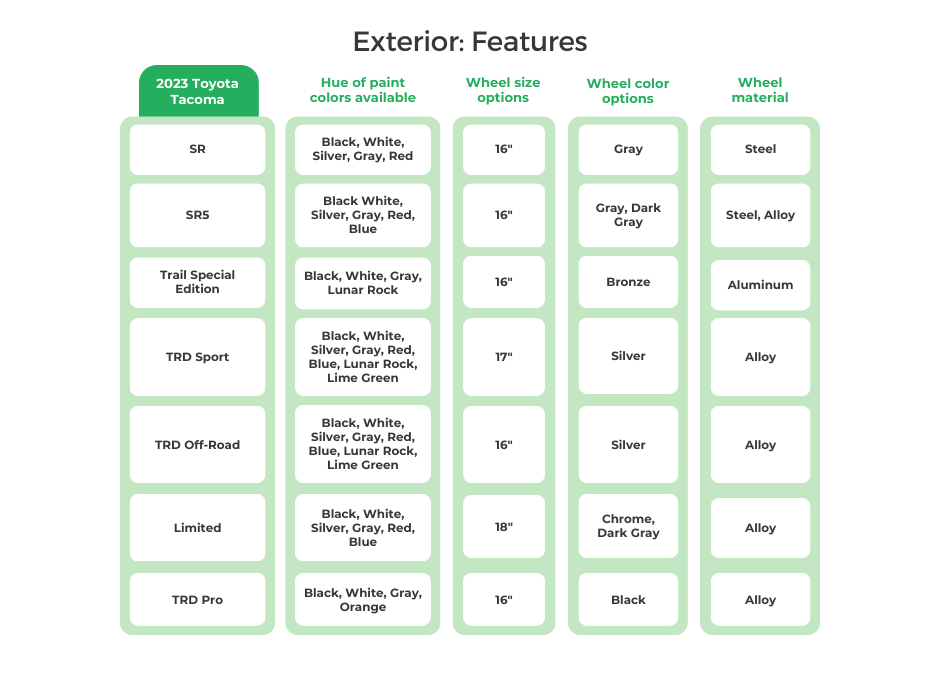
Exterior Dimensions:
The Frontier and Tacoma have similar exterior sizes, but the Tacoma is slightly bigger if you want to get into specific measurements. At 212.3 inches in length, the Tacoma is about two inches longer than the Frontier. The difference is less when working a six-foot cargo bed into the conversation. The Frontier is as much as two inches narrower, depending on the trim. Except for an unusually tight parking space, the Tacoma will fill where a Frontier will fit.
Buyers, however, should pay attention to ground clearance, as the Tacoma has more of it. That’s good if travel involves uneven surfaces but can require extra effort while getting in and out.
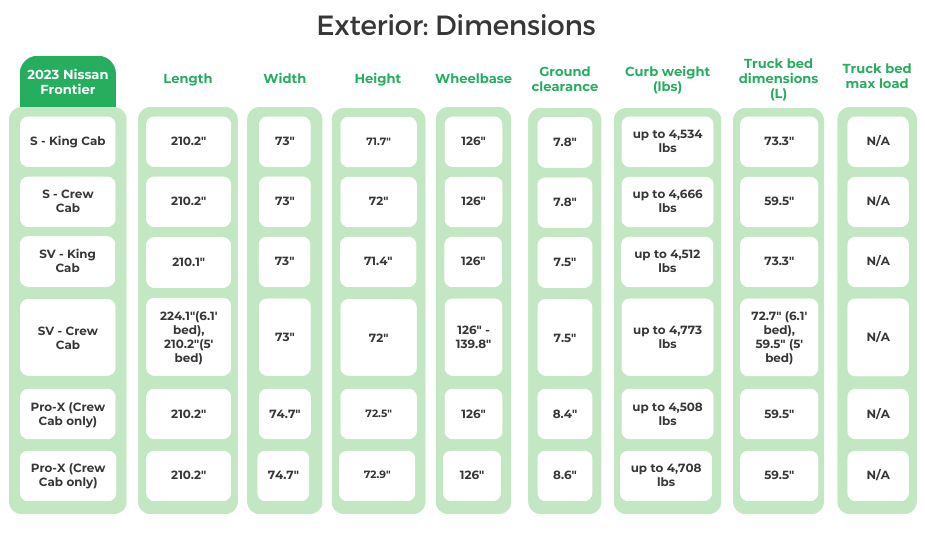

Warranty:
Quick Take: Warranty coverage for the Frontier and Tacoma is almost identical, but Toyota includes two years of free maintenance.
The Frontier and Tacoma have near-identical factory warranties. Both trucks have bumper-to-bumper coverage for three years or 36,000 miles, and powertrain protection lasts for five years or 60,000 miles.
Nissan includes three years or 36,000 miles of roadside assistance, while Toyota’s version is good for two years or 25,000 miles. The greatest warranty separator is that Toyota includes two years or 24,000 miles of free scheduled maintenance. Frontier owners receive no such benefit.
Toyota’s recommended maintenance schedule for the 2023 Tacoma calls for at least three oil and filter changes during the first two years. FIXD research shows the average professional oil change service costs as much as $120. So, add the numbers, and Tacoma owners save at least $360. The amount increases if the value of complimentary inspections and fluid top-offs are included.
The savings from Toyota’s free maintenance program aren’t huge, but they could tip the balance in the Tacoma’s favor.
| 2023 Nissan Frontier Factory Warranty Coverage: | 2023 Toyota Tacoma Factory Warranty Coverage: | |
| Basic warranty: | 36 months/ 36,000 miles | 36 months/ 36,000 miles |
| Powertrain warranty: | 60 months/ 60,000 miles | 60 months/ 60,000 miles |
| Corrosion perforation warranty: | 60 months/ Unlimited Miles | 60 months/ Unlimited Miles |
| Air conditioning warranty: | included in Basic Warranty | included in Basic Warranty |
| Battery warranty: | 24 months | NA |
| Emissions warranty: | Federal: 36 month/ 36,000 miles (defect), 24 months/ 24,000 miles (performance). California: 36 months/ 50,000 miles (performance) | Federal: 36 months/ 36,000 miles (defect), 24 months/ 24,000 miles (performance). California: 36 months/ 50,000 miles (performance) |
| Complimentary scheduled maintenance: | None | 24 months/25,000 miles |
| Roadside assistance coverage: | 36 months/ 36,000 miles | 24 months |
| Total unique recalls: | 1 | 2 |
Methodology
- Compare two vehicles, the Nissan Frontier and the Toyota Tacoma, and provide a comprehensive analysis.
- Gather relevant information and data on both vehicles from reliable sources, such as manufacturer specifications, expert reviews, customer feedback, industry reports, and data sources like manufacturer websites, FIXD App, Kelley Blue Book, FuelEconomy.gov, and NHTSA.
- Collect data on various aspects, including performance, safety features, fuel efficiency, maintenance costs, reliability, owner satisfaction, and market value.
- Identify the key criteria that will be used to evaluate and compare the two vehicles.
- Ensure the criteria cover both objective factors (such as performance metrics, safety ratings, and fuel efficiency) and subjective factors (such as owner satisfaction, comfort, and features).
- Assess the performance of both vehicles based on factors such as acceleration, handling, braking, and overall driving experience.
- Compare engine options, horsepower, torque, transmission options, and any unique performance features.
- Examine the safety features and ratings of both vehicles.
- Evaluate crash test ratings, advanced driver assistance systems (ADAS), active and passive safety features, and any notable recalls or known issues related to safety.
- Consider both NHTSA safety ratings and IIHS awards for a comprehensive safety assessment.
- Analyze the fuel economy of both vehicles based on EPA mileage estimates.
- Compare their MPG ratings, average full-tank range, and any significant differences in fuel efficiency.
- Compare the features and technologies offered by both vehicles.
- Highlight any notable differences in terms of infotainment systems, connectivity options, driver assistance features, interior quality, and available upgrades.
- Summarize the findings of the comparison, highlighting the positives and negatives of each vehicle.
- Provide a fair and balanced recommendation based on the comparison, considering factors such as budget, personal preferences, specific needs of the buyer, and the comprehensive analysis conducted.
Sources:
- Fuel Economy: Mileage-per-gallon estimates according to the EPA MPG on Fueleconomy.gov.
- Safety Ratings: Crash test data collected and reported by NHTSA, as well as IIHS Award information, were collected for this article.
- Vehicle Prices/Features: Most or all information gathered on vehicle features was from the manufacturer’s website, in this case, nissanusa.com and toyota.com.

Dave Goldberg is an automotive journalist and lifelong car fanatic. He writes for numerous enthusiast and business outlets and is an ongoing contributor to HotCars.com, one of the most popular car culture websites. When he’s not writing or driving, Dave is either under a hood or asleep. His credentials include a BA in Journalism from The George Washington University.

